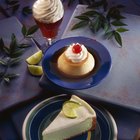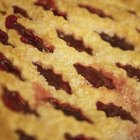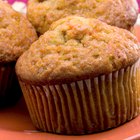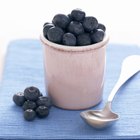
Lemon icebox pie is an old-school Southern favorite, and like many such vintage recipes, it enjoys periodic revivals as diners seek out different kinds of down-home comfort food. Although there is a simplified, uncooked version of the dessert using cream cheese, most use a cooked filling that varies from traditional lemon pie in its use of sweetened condensed milk. If your pie filling doesn't set properly, you can try again using an additional egg yolk or a starch thickener.
Yolk Method
Step 1
Spoon the un-set filling out of your pie shell into a bowl or large measuring cup. If it's on a crumb crust, it might be simpler to pour it through a strainer and strain out the crumbs, then start over with a fresh crust. If your filling is still in the original mixing bowl or double boiler, set it aside near your work space.
Step 2
Separate an egg, and place the yolk in a clean mixing bowl or double boiler, large enough to hold the amount of filling you've made. Whisk it with 1 tablespoon of water or lemon juice, until light-colored and foamy.
Step 3
Whisk a few tablespoons of the failed filling into the new egg yolk, ensuring it's well mixed. Pour the warm filling into the egg yolk mixture in a slow, fine stream, stirring constantly. If your filling had cooled, heat it gently until it's warm to the touch before incorporating it into the egg mixture.
Step 4
Transfer the double boiler or mixing bowl to the top of a saucepan filled with simmering water. Whisk or stir the filling gently until it thickens, at a temperature of about 140 degrees Fahrenheit.
Step 5
Pour the newly thickened filling into the original crust, or a new crust if necessary. Chill for four to six hours, until completely set, before slicing.
Starch Method
Step 1
Scoop the filling from your pie shell carefully into a bowl. If the un-set filling is still in your mixing bowl or double boiler, set it to the side of your workspace.
Step 2
Whisk 1 to 2 tablespoons of cornstarch into 4 tablespoons of cold water, until it forms a smooth slurry with no lumps. Combine the cornstarch mixture with an equal quantity of the failed filling, then whisk this mixture thoroughly into the main bowl of filling.
Step 3
Place the bowl or double boiler containing your filling over a saucepan filled with simmering water. Stir the filling diligently as it reheats. At a temperature between 140 F and 150 F, the cornstarch will suddenly begin to gel, thickening the filling dramatically. Heat for another two minutes, stirring occasionally, to ensure the cornstarch has gelled completely.
Step 4
Pour the thickened filling into a prepared pie shell. Refrigerate the pie for four to six hours before slicing.
Related Articles

How to Thicken a Lemon Filling in Baking

How to Fix Grainy Whipped Ganache

How to Fix Lumpy Buttercream Frosting

How Can I Thicken Sloppy Joes?

Why Is My Pastry Cream Hardened?

How to Mix an Amaretto Sour Drink With ...

How to Soften a Stiff Buttercream

Sugar-Free Coconut Cream Pie

What Happens if You Whip Condensed Milk?

How to Decorate Cake Using Heavy ...

Healthy Pie Crusts With Garbanzo Bean ...

How to Make Pineapple Empanadas

Substitute for Manioc Starch

How to Thicken Stew With Flour

How to Freeze Pavlova

How to Mend a Broken Friendship With a ...

How to Thicken Cream Filling

Can You Thicken Alcohol With Gelatin?

How to Stiffen Frosting

How Do I Thicken Blueberries to Make ...
References
- The Professional Pastry Chef; Bo Friberg
- On Food and Cooking: The Science and Lore of the Kitchen; Harold McGee
Tips
- Icebox lemon pie is similar to Key lime pie, which makes similar use of sweetened condensed milk. If your recipe for icebox lemon pie is unreliable but you have a good recipe for Key lime pie, compare the two recipes and see how they differ.
- The quantities are for the filling for a standard 8- or 9-inch pie. If you're using a larger or deeper pie plate, use a second egg yolk or the larger quantity of cornstarch.
Writer Bio
Fred Decker is a trained chef and prolific freelance writer. In previous careers, he sold insurance and mutual funds, and was a longtime retailer. He was educated at Memorial University of Newfoundland and the Northern Alberta Institute of Technology. His articles have appeared on numerous home and garden sites including GoneOutdoors, TheNest and eHow.
Photo Credits
Dynamic Graphics Group/Dynamic Graphics Group/Getty Images